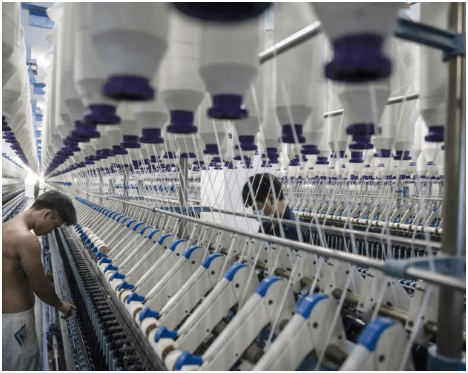China post-pandemic economic recovery is showing signs of losing momentum, raising concerns about the sustainability of its growth amid weak consumer demand and sluggish industrial production.
While the world’s second-largest economy initially bounced back strongly after the COVID-19 pandemic, recent data indicates that the recovery may be faltering. As various sectors struggle to regain their pre-pandemic pace, analysts believe that additional government intervention could be required to stabilize the economy and restore confidence among consumers and businesses.
Weak consumer demand has emerged as one of the primary challenges, hampering economic momentum. Despite efforts to boost domestic consumption, household spending remains subdued. Lingering uncertainties about job security, declining property values, and stagnant wage growth have led to cautious consumer behavior. While retail sales figures have shown occasional signs of improvement, they have fallen short of expectations, underlining the fragility of the recovery. Moreover, consumer confidence has been slow to rebound, with many households opting to save rather than spend, fearing economic instability in the near future.
The industrial sector, a traditional pillar of China’s economic strength, is also experiencing a slowdown. Weak global demand, rising geopolitical tensions, and supply chain disruptions have weighed on exports, which are a critical component of China’s growth model. In addition, challenges in key manufacturing hubs have affected production output, further dampening the industrial sector’s recovery. Analysts note that although some industries, such as electric vehicles and renewable energy, continue to show resilience, broader manufacturing activity has struggled to gain consistent traction. Industrial production, a key economic indicator, has seen fluctuations that reflect ongoing uncertainties in both domestic and international markets.
The property market, another significant driver of China’s economy, remains under pressure, adding to concerns about growth prospects. Large developers are grappling with debt crises, with several high-profile real estate firms defaulting on payments. Falling property prices have eroded household wealth, leading to reduced consumer spending and increased caution in real estate investments. While the government has introduced policies to stabilize the property market, including easing mortgage rules and offering incentives for homebuyers, the sector’s recovery has been uneven. Property developers are also hesitant to launch new projects amid weak demand, further contributing to the slowdown.
In response to these challenges, the Chinese government has already implemented several measures, including cuts to interest rates, tax incentives, and infrastructure investments. However, the effectiveness of these policies has been limited, as underlying economic issues continue to weigh heavily on the recovery. Analysts suggest that further fiscal and monetary stimulus may be necessary to prevent growth from stalling. The central government faces a delicate balancing act, as it aims to stimulate economic activity without exacerbating inflationary pressures or increasing financial risks.
Economists also point to structural challenges that could hinder long-term growth, such as an aging population, high levels of corporate debt, and geopolitical uncertainties. China’s export-driven growth model is facing headwinds from shifting global trade dynamics, with many countries diversifying their supply chains to reduce dependence on Chinese manufacturing. Furthermore, trade tensions between China and major economies, including the United States and the European Union, have complicated the recovery, affecting business sentiment and investment flows.
Despite these challenges, there are areas where China’s economy continues to show resilience. The tech sector, driven by advancements in artificial intelligence and digital innovation, remains a bright spot, with companies expanding into new markets and developing cutting-edge technologies. The push toward green energy and sustainability has also opened up opportunities in sectors such as solar power, electric vehicles, and battery manufacturing. Government initiatives aimed at boosting consumption, such as digital yuan trials and incentives for the tourism industry, are also expected to provide some relief in the coming months.
However, achieving a sustainable recovery will require coordinated policy efforts that address both short-term economic pressures and long-term structural issues. Experts believe that targeted stimulus measures, such as support for small and medium-sized enterprises (SMEs) and additional incentives to boost domestic consumption, could be critical in stabilizing the economy. Strengthening social safety nets, improving healthcare access, and addressing concerns around unemployment are also essential to restoring consumer confidence and encouraging spending.
Another factor that could shape China’s economic outlook is the evolving global environment. The country’s ability to navigate geopolitical challenges and maintain stable trade relations will play a significant role in determining the pace of recovery. Continued engagement in multilateral trade agreements and regional partnerships could help mitigate some of the risks associated with decoupling from global supply chains. Additionally, China’s Belt and Road Initiative remains a key strategy to enhance connectivity and boost trade with emerging markets, potentially offsetting some of the external pressures on the economy.
In the months ahead, all eyes will be on China’s policymakers as they weigh their options for stimulating growth without creating financial imbalances. The central bank may opt for further interest rate cuts, while additional fiscal spending on infrastructure projects could help revitalize economic activity. However, analysts caution that stimulus alone may not be sufficient to address the deeper challenges facing the economy. Structural reforms, such as improving corporate governance, reducing debt levels, and fostering innovation, will be essential to ensuring long-term stability and growth.
Overall, China’s economic recovery is at a critical juncture, with both risks and opportunities on the horizon. While the government’s existing policies have provided some support, sustained growth will depend on addressing the underlying issues that have contributed to the current slowdown. With global economic uncertainties persisting, China’s recovery trajectory will have significant implications not only for the country but also for the broader global economy. As the Chinese government prepares to navigate this challenging period, its decisions will likely shape the future of the nation’s economic landscape for years to come.
